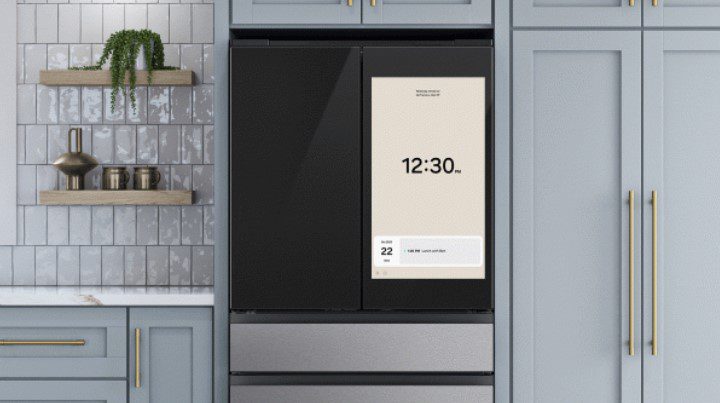
samsung makes ads on 3 499 smart Samsung has officially confirmed that its high-end smart fridges will soon feature advertisements, a move that follows an unpopular pilot test conducted last month.
samsung makes ads on 3 499 smart
Overview of the New Advertising Feature
Samsung’s 2024 Family Hub smart fridges, which carry a price tag ranging from $1,899 to $3,499, will be the first to showcase this new advertising initiative. The ads will be displayed on the integrated screens of these fridges, which are either 21.5 or 32 inches in size, depending on the model. This feature will be rolled out through a software update that Samsung plans to issue in the coming weeks.
Details of the Software Update
The software update will introduce a new widget designed specifically for select Cover Screens themes of the Family Hub refrigerators. This widget will not only display curated advertisements but also provide users with useful day-to-day information, including:
- News updates
- Calendar events
- Weather forecasts
Samsung has emphasized that the ads displayed will be contextualized rather than personalized. This means that the advertisements will not rely on collecting user data, which has become a significant concern for many consumers in recent years. Instead, the ads will be relevant to the general context of the user’s environment, such as seasonal promotions or local events.
Consumer Reactions and Concerns
The announcement has sparked a variety of reactions from consumers and industry experts alike. Many users have expressed their discontent regarding the introduction of ads on appliances that are already priced at a premium. The sentiment is that consumers should not have to endure advertisements on devices they have paid a substantial amount for.
Historical Context of Smart Appliances
Smart appliances, including refrigerators, have gained popularity over the past decade, driven by advancements in technology and the growing trend of connected homes. These devices often come equipped with features such as touchscreen interfaces, internet connectivity, and compatibility with smart home ecosystems. However, the introduction of ads raises questions about the balance between functionality and user experience.
Consumer Sentiment Towards Ads in Appliances
Consumer sentiment towards advertisements in household appliances has been largely negative. Many users feel that the presence of ads detracts from the primary purpose of the appliance. For instance, a refrigerator is primarily intended for food storage, not as a platform for advertising. The concern is that the introduction of ads could lead to a cluttered user interface, making it more difficult for users to access essential features.
Implications for the Smart Appliance Market
The decision to incorporate ads into smart fridges could have broader implications for the smart appliance market. As manufacturers look for new revenue streams, the trend of advertising on appliances may become more common. This could lead to a shift in how consumers perceive the value of smart appliances.
Potential for Revenue Generation
For Samsung, the introduction of ads could represent a significant revenue opportunity. By partnering with brands to showcase their products, Samsung could potentially offset some of the costs associated with manufacturing and marketing its high-end appliances. This could allow the company to offer more competitive pricing in the future.
Challenges and Risks
However, this strategy is not without its challenges. Samsung risks alienating a segment of its customer base that values a seamless user experience. If consumers feel overwhelmed by advertisements, they may choose to avoid smart appliances altogether or opt for competitors that do not incorporate ads into their products. This could ultimately impact Samsung’s market share in the smart appliance sector.
Stakeholder Reactions
Reactions from stakeholders in the technology and appliance industries have been mixed. Some industry analysts believe that Samsung’s move could set a precedent for other manufacturers to follow. If successful, this model could encourage more companies to explore advertising as a revenue stream.
Industry Expert Opinions
Industry experts have pointed out that while the introduction of ads may provide short-term financial benefits, it could also lead to long-term brand damage if not executed carefully. The key will be finding a balance between monetization and maintaining a positive user experience.
Consumer Advocacy Groups
Consumer advocacy groups have also weighed in on the issue, expressing concerns about the implications of advertising on household appliances. They argue that consumers should have the right to opt-out of ads, especially on products that they have already purchased. The potential for intrusive advertising could lead to calls for stricter regulations in the smart appliance market.
Future of Smart Appliances and Advertising
The future of smart appliances may hinge on how companies like Samsung navigate the introduction of advertising. As the market continues to evolve, manufacturers will need to consider consumer preferences and the potential backlash against intrusive advertising.
Consumer Preferences
Understanding consumer preferences will be crucial for manufacturers looking to implement advertising in their products. Surveys and focus groups could provide valuable insights into how consumers feel about ads in appliances and what types of ads they would find acceptable.
Technological Innovations
Technological innovations may also play a role in how advertising is integrated into smart appliances. For instance, advancements in artificial intelligence could allow for more relevant contextual ads without infringing on user privacy. This could help alleviate some consumer concerns while still providing manufacturers with a revenue stream.
Conclusion
Samsung’s decision to introduce advertisements on its high-end smart fridges marks a significant shift in the appliance industry. While the move may offer financial benefits for the company, it also raises important questions about consumer experience and the future of smart appliances. As the rollout of this feature begins, it will be essential for Samsung to monitor consumer reactions and adapt its strategy accordingly. The balance between monetization and user satisfaction will ultimately determine the success of this initiative and could set a precedent for the future of advertising in smart appliances.
Source: Original report
Was this helpful?
Last Modified: October 29, 2025 at 3:39 am
0 views















